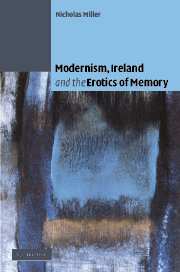Book contents
- Frontmatter
- Contents
- List of illustrations
- Acknowledgments
- Introduction. All history is local: modernism and the question of memory in a global Ireland
- Part I THE EROTICS OF MEMORY
- 1 Lethal histories: memory-work and the text of the past
- 2 A Pisgah sight of history: critical authority and the promise of memory
- 3 A reservation under the name of Joyce: Rossellini's Viaggio in Italia and the symptom
- Part II THE SPECTACLES OF HISTORY
- Afterword. The ends of memory and the ex-sistence of Ireland
- Notes
- Bibliography
- Index
1 - Lethal histories: memory-work and the text of the past
Published online by Cambridge University Press: 22 September 2009
- Frontmatter
- Contents
- List of illustrations
- Acknowledgments
- Introduction. All history is local: modernism and the question of memory in a global Ireland
- Part I THE EROTICS OF MEMORY
- 1 Lethal histories: memory-work and the text of the past
- 2 A Pisgah sight of history: critical authority and the promise of memory
- 3 A reservation under the name of Joyce: Rossellini's Viaggio in Italia and the symptom
- Part II THE SPECTACLES OF HISTORY
- Afterword. The ends of memory and the ex-sistence of Ireland
- Notes
- Bibliography
- Index
Summary
A historical phenomenon, known clearly and completely and resolved into a phenomenon of knowledge, is, for him who has perceived it, dead.
Friedrich Nietzsche “On the Uses and Disadvantages of History for Life”In the dark, early morning hours of a spring night in 1990, a group of unlikely urban guerrillas entered the public square that fronts the Saarbrücker Schloss, a historic castle in the city of Saarbrücken, Germany. There they began digging up and removing a small number of the cobblestones with which the square is paved, concealing their work from the daytime gaze of palace guards and police by placing false, “dummy” stones in each of the resulting holes. Their work completed, the thieves deposited the stolen cobblestones at their base of operations in a nearby school and parted company, returning to their respective homes to sleep. The perpetrators of this odd theft, or exchange, of municipal property were art students, members of visiting professor Jochen Gerz's seminar on memorial design at the local art academy, the Hochshule der Bildenden Künste; their nocturnal sojourn into the square was only the first of many in what was to become an extraordinary collective undertaking: the clandestine design and installation of a public memorial dedicated to the victims of Germany's wartime past.
The stimulus for the unusual project had been provided by the history of the Saarbrücker Schloss itself. Originally built as a home for German royalty, the palace functioned during World War II as a Gestapo headquarters.
- Type
- Chapter
- Information
- Modernism, Ireland and the Erotics of Memory , pp. 21 - 38Publisher: Cambridge University PressPrint publication year: 2002



